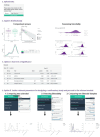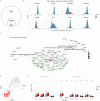This is a preprint.
BifurcatoR: A Framework for Revealing Clinically Actionable Signal in Variance Masquerading as Noise
- PMID: 40502166
- PMCID: PMC12157621
- DOI: 10.1101/2025.06.01.657083
BifurcatoR: A Framework for Revealing Clinically Actionable Signal in Variance Masquerading as Noise
Abstract
Background: Disease heterogeneity is a persistent challenge in medicine, complicating both research and treatment. Standard analytical pipelines often assume patient populations are homogeneous, overlooking variance patterns that may signal biologically distinct subgroups. Variance heterogeneity (VH)-including skewness, outliers, and multimodal distributions-offers a powerful but underused lens for detecting latent etiological structures relevant to prognosis and therapeutic response.
Methods: A major barrier to VH analysis is the fragmented landscape of available methods, many of which rely on normality assumptions that biological data frequently violate. In addition, existing tools often require programming expertise, and clear guidance on study design considerations-such as sample size and method selection-is lacking. To address these issues, we developed BifurcatoR, an open-source software platform that simplifies the detection, modeling, and interpretation of VH. BifurcatoR integrates simulation-based method evaluation, study design recommendations, and a user-friendly web interface to support VH analysis across a range of data distributions. We benchmarked VH methods through simulation and applied BifurcatoR to two clinical datasets: acute myeloid leukemia (AML) and obesity.
Results: Simulation studies revealed that VH method performance is highly context-specific, varying with distribution shape, mean-variance coupling, and underlying subgroup structure. In AML, BifurcatoR identified two molecularly distinct subgroups with different treatment responses, including an EVI1-high group with significantly poorer prognosis (p < 0.005) among KMT2A-rearranged cases. In a separate study, VH analysis uncovered immunophenotypic subgroups in obesity based on gene-level discordance across monozygotic twin pairs, highlighting latent variation in adipose immune cell composition.
Conclusions: VH is not "noise", biological variation without clinical relevance. Instead, VH is a structured signal that can reveal latent and clinically meaningful subtypes. BifurcatoR offers a practical, accessible framework for incorporating VH into biomedical research, with implications for biomarker discovery, patient stratification, and precision medicine.
Keywords: cancer; epigenetics; heterogeneity; obesity; phenotypic noise; twins; variability.
Figures



References
-
- Cremin CJ, Dash S, Huang X. Big data: Historic advances and emerging trends in biomedical research. Current Research in Biotechnology 2022;4:138–151. DOI: 10.1016/j.crbiot.2022.02.004. - DOI
Publication types
Grants and funding
LinkOut - more resources
Full Text Sources
